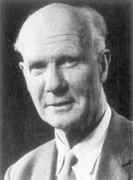Person: Pearson (2), Egon

Egon Pearson was an English statistician who worked on statistical hypothesis testing. He was the son of Karl Pearson.
Mathematical Profile (Excerpt):
- At the end of one year of study, Pearson left Cambridge in 1915 determined to make a contribution to the war effort, and he worked for the Admiralty and the Ministry of Shipping.
- Pearson never took up his undergraduate studies at Cambridge again after the war but was awarded his B.A. in 1920 after taking the Military Special Examination in 1919 which had been set up to cope with those who had their studies disrupted by the war.
- Pearson also attended astronomy lectures by F J M Stratton and undertook work with F L Engledow and G U Yule.
- In 1924 Pearson became an assistant editor of Biometrika but perhaps one of the most important events for his future research happened in the following year.
- Even then it took place simply because Karl Pearson's health prevented him teaching, rather than for positive reasons.
- Pearson and Neyman agreed to undertake a joint research project in June 1926, just before Neyman left for Paris.
- Their joint research was carried on by letters, but there were meetings such as in the spring of 1927 when Pearson visited Neyman in Paris.
- The decade-long joint work of Egon and myself was aimed at building a mathematical theory of tests the use of which could minimise the frequency of erroneous conclusions regarding the hypotheses considered ...
- There was a second major correspondence which Pearson carried out over much the same period as the Neyman-Pearson collaboration.
- This was one which Pearson carried out with Gosset, and Gosset's ideas played a big role in the discussions between Pearson and Neyman.
- Pearson visited the United States in 1931 and, in addition to lecturing in Iowa, he held discussions with Shewhart in the Bell Telephone Laboratories in New York.
- The following year Shewhart visited Pearson in London and their discussions on quality control in industry led to the creation of the Industrial and Agricultural Research Section of the Royal Statistical Society.
- In 1933 Karl Pearson retired from the Galton Chair of Statistics which he had held in University College London.
- Against his wishes the University authorities decided to split the Department into two separate departments; the Galton Chair and Head of the Department of Eugenics went to Fisher, while Egon Pearson was appointed Reader and became Head of the Department of Applied Statistics.
- If Karl Pearson did not like that arrangement, then certainly neither did Fisher.
- Neyman had already left London in 1938 for a post in Berkeley and with the outbreak of war Pearson began to undertake war work for the Ordinance Board undertaking statistical analysis of the fragmentation of shells hitting aircraft and similar work.
- Pearson had found the years working in the same institution as Fisher very difficult.
- Karl Pearson had attacked Fisher aggressively and had, in return, been attacked aggressively by Fisher.
- However, even after Karl Pearson died, Fisher kept up his attack on him in print and Egon Pearson must have found it difficult to share a building with Fisher.
- After Fisher moved away from London in 1939, especially after he began to work at Cambridge from 1943, Pearson must have found the atmosphere in London a much happier one.
- In addition to the honours which we have mentioned above, Pearson was awarded the Gold Medal of the Royal Statistical Society in 1955.
Born 11 August 1895, Hampstead (near London), England. Died 12 June 1980, Midhurst, Sussex, England.
View full biography at MacTutor
Tags relevant for this person:
Origin England, Statistics
Thank you to the contributors under CC BY-SA 4.0! 

- Github:
-

- non-Github:
- @J-J-O'Connor
- @E-F-Robertson
References
Adapted from other CC BY-SA 4.0 Sources:
- O’Connor, John J; Robertson, Edmund F: MacTutor History of Mathematics Archive
